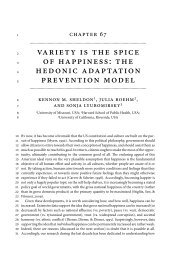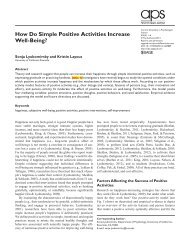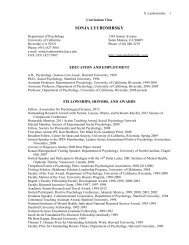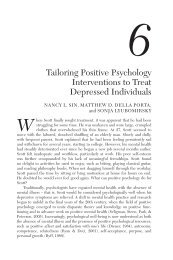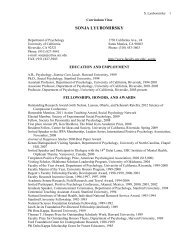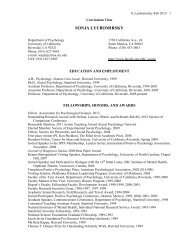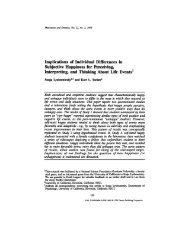Toward a Durable Happiness - Sonja Lyubomirsky
Toward a Durable Happiness - Sonja Lyubomirsky
Toward a Durable Happiness - Sonja Lyubomirsky
- No tags were found...
You also want an ePaper? Increase the reach of your titles
YUMPU automatically turns print PDFs into web optimized ePapers that Google loves.
Path:K:/GWD-LOPEZ-08-0210/Application/GWD-LOPEZ-08-0210-002_V4.3dDate: 4th June 2008 Time: 20:56 User ID: ibrahimm BlackLining EnabledPage Number: 23TOWARD A DURABLE HAPPINESS23‘‘subjective well-being’’ (or simply ‘‘well-being’’) is often used as a synonymfor happiness, as it will be throughout this chapter.CAN HAPPINESS BE INCREASED? REASONS FOR PESSIMISMIs it possible to actually become happier? You may be surprised to learnthat, until fairly recently, there was very little scientific data to tell uswhether or not people can lastingly boost their happiness. In fact, in previousyears, researchers were doubtful about the possibility of becoming happier.Two reasons underlie their pessimism—first, happiness is partiallydetermined by genetics, and, second, people tend to adapt (or get used to)most positive life experiences, and what initially brought them great pleasuregradually ceases to do so. Therefore, some say, any attempts to increasehappiness would be futile, because people would simply return to their geneticallydetermined happiness ‘‘baseline’’ following a pleasant experience.We describe the evidence for this perspective below.The Roles of Heredity and PersonalityThe baseline level of happiness, or set point, is higher for some peoplethan for others. In other words, some of you are naturally, or dispositionally,happier than others. Years of research on fraternal and identical twinshas led psychologists to conclude that this baseline is determined by genetics(Lykken & Tellegen, 1996). In other words, if you had an identicaltwin, he or she would share your height, intelligence, and predisposition tohypertension, and your level of happiness as well.The fact that happiness has a high heritability is also consistent withthe finding that a person’s level of happiness is strongly related to hisor her standing on several personality traits (Diener & Lucas, 1999).Forexample,peoplewhoarehighlyneurotictendtobelesshappy,andextraverts are inclined to be happier than introverts. Traits such as theseare relatively fixed, meaning that, throughout the life span, people generallydo not change much in where they stand on extraversion, neuroticism,and so forth (McCrae & Costa, 1994). Some researchers have usedthese findings to argue that happiness is yet another personality trait—stable and resistant to any kind of meaningful change (Costa, McCrae, &Zonderman, 1987).Hedonic AdaptationThe theory of hedonic adaptation provides another source of pessimismabout the possibility of lastingly increasing happiness. Simply put, this isthe tendency for the emotional impact of both positive and negative eventsto diminish over time (Brickman & Campbell, 1971; Diener, Lucas, &Napa Scollon, 2006). To illustrate, think about a time in your life whensomething extremely good happened to you. It may be something you haddaydreamed about and strove for, such as getting accepted into the college
Path:K:/GWD-LOPEZ-08-0210/Application/GWD-LOPEZ-08-0210-002_V4.3dDate: 4th June 2008 Time: 20:56 User ID: ibrahimm BlackLining EnabledPage Number: 25TOWARD A DURABLE HAPPINESS25REASONS FOR OPTIMISM: THE SUSTAINABLE HAPPINESS MODELSome researchers have used the findings we have just described to supportthe claim that the quest to improve happiness is a fruitless effort(Lykken & Tellegen, 1996). Fortunately, both the fact that happiness has agenetic component and the fact that we adapt to positive life events doesnot mean that it is impossible to become happier. New research suggeststhat a person’s level of happiness is not set in stone, and that he or she canraise this level by taking advantage of certain intentional activities.As explained below, the sustainable happiness model (<strong>Lyubomirsky</strong>,Sheldon, & Schkade, 2005) proposes that happiness is determined by threefactors: The genetically determined set point, life circumstances, and intentionalactivities (see Figure 2.1). The implication of this model is that alarge percentage of your happiness is determined by your own conscious,effortful activities and, thus, that increases in happiness can be successfullyachieved.The Set PointThe largest piece of the pie is known as the set point—quite literally, thepoint at which one’s happiness level is set, or fixed. People tend to have alevel of happiness that they gravitate back to following a significant event,and this set point is higher for some people than for others. In otherwords, some are born happier than others. You probably know people whoalways seem to be in good spirits and are habitually looking on the brightside. As the saying goes, when life gives them lemons, they make lemonade.On the other hand, you are likely also familiar with people who are generallyunhappy. They see the glass as half empty, and find it hard to derivemuch pleasure from their daily lives. Psychologists would say that these twosets of people have different set points for well-being. Years of researchfrom a field called ‘‘behavioral genetics’’ has led psychologists to concludethat this set point for happiness is determined by genetics (Lykken &Figure 2.1. What Determines <strong>Happiness</strong>?
Path:K:/GWD-LOPEZ-08-0210/Application/GWD-LOPEZ-08-0210-002_V4.3dDate: 4th June 2008 Time: 20:56 User ID: ibrahimm BlackLining EnabledPage Number: 2828 PURSUING HUMAN FLOURISHINGexpressed their gratitude did show increases in well-being over a 6-weektime period, but only those who did the writing exercise only once a week.When writing three times a week, participants did not become lastinglyhappier, possibly because the exercise grew to be routine, frustrating, orboring.Writing letters to express your appreciation is another way to create agrateful mind-set and thereby foster happiness. One study (Dickerhoof,<strong>Lyubomirsky</strong>, & Sheldon, 2007) found that writing gratitude letters to specificpeople, for 15 minutes once a week over the course of 8 weeks, producedboosts in happiness that persisted over the course of the study andwere still apparent as long as 9 months after the study was over. This wastrue even for those individuals who did not share or deliver their letters.However, in real life, many people have the desire to actually tell theobjects of their gratitude how much they are appreciated. This is also aneffective strategy for increasing happiness and for fostering good relationships.In an online study, Seligman, Steen, Park, and Peterson (2005)instructed a group of participants to think of a person to whom they weregrateful but had never properly thanked. Then this group was asked notonly to write a gratitude letter but also to deliver it to the recipient. As aresult, relative to a control group, these participants reported increases intheir happiness that persisted for a full month.Why Does It Work?Why does expressing gratitude increase happiness? There are severallikely reasons. First, feeling grateful for what you have helps to undo theeffects of adaptation mentioned above, thereby changing the way youregard your life. To illustrate, think for a moment about the pleasant butconstant things you encounter in your daily life, such as a beautiful treeoutside your window, a good-natured and helpful coworker, your favoritelocal restaurant, or your best friend. However pleasant these thingsare, people have a tendency to stop appreciating them over time, or asmentioned previously, to adapt to them (Brickman & Campbell, 1971).But when you are in a grateful mind-set, which may be brought on bytelling your best friend or coworker how much they mean to you, writinga detailed account of all the positive attributes of your favorite restaurant,or simply making a list of several pleasant aspects of your immediateenvironment, you are bringing these things to the forefront of yourattention, relishing them, and appreciating them more fully. In otherwords, these activities aid in savoring and create a positive focus on presentexperience.The happiest people are those who report having strong social supportand close relationships (Myers, 2000). Thus, another reason why expressinggratitude is beneficial is that it can help foster these important socialbonds. Specifically, when you are feeling grateful for the people in your life,you may feel motivated to spend more time with them and to treat themwell (Emmons & Shelton, 2002). A ‘‘gratitude visit’’ exercise, such as the
Path:K:/GWD-LOPEZ-08-0210/Application/GWD-LOPEZ-08-0210-002_V4.3dDate: 4th June 2008 Time: 20:56 User ID: ibrahimm BlackLining EnabledPage Number: 3232 PURSUING HUMAN FLOURISHINGbenefactor, which strengthens their relationship. Moreover, doing thingsfor others is socially engaging. It often requires direct interaction with peopleyou may never meet or get to know well. Volunteers at a nursing homemay learn the often-remarkable life histories of the patients. A math tutormay come to appreciate that his student is actually hard-working, but thathe excels in the arts, rather than at math. Working at a homeless sheltermay make you aware of the particular challenges faced by people living allaround you. In this way, prosocial behavior can create a sense of empathyfor the recipients. Therefore, it is no surprise that people who volunteerreport feeling greater ties to the community (Putnam, 2000).CHOOSING A HAPPINESS-INCREASING ACTIVITYRight now you may be feeling quite motivated to try out some of theseexercises in your own life. We offer some specific instructions on how to dothis in the Personal Mini-Experiments at the end of the chapter. In addition,this section provides some helpful advice on how to make these happinessactivities work best for you.To reiterate and summarize what was mentioned above, too much of agood thing with regard to these activities is possible. It is important tokeep them fresh, meaningful, and exciting, so we advise you to be mindfulof the frequency with which you are doing them. Once a week seems like agood rule-of-thumb, and is consistent with the findings mentioned above(e.g., <strong>Lyubomirsky</strong>, Sheldon, et al., 2005). Performing the activities morefrequently than this may inadvertently turn them into predictable, routine,or boring chores.Also, consider ways that you might vary the activity you choose to engagein. For example, if your preferred activity is to express gratitude, think ofhow you could keep this feeling novel. One possibility is that you couldfocus in and expand on a different domain of life each week. For example,you might write about nature one week, your personal life the next, andyour health the next. Ideally, each time you do this exercise, you will focusin on new things for which you can express gratitude, thereby finding moreand more things that are worthy of your attention and appreciation.As anyone who has achieved long-term weight loss, earned a collegedegree, or finished a marathon can attest, most meaningful successes in lifedo not come easily or quickly. In keeping with this notion, it is importantto remember that improving your level of happiness requires committedeffort. Research has found that those who have increased their happinessmost successfully have been those individuals who have persisted with theintentional activities over the course of weeks or months (Dickerhoof et al.,2007; Sheldon & <strong>Lyubomirsky</strong>, 2006). This means committing to both initiatingand maintaining the happiness activities over a long period of time.As is the case with any goal, long-term commitment is required for success.The activities described above do not work equally well for all. Accordingly,it is important to choose an activity that ‘‘fits’’ with your personalityand goals. By fit, we mean that the activity feels natural and genuine to
Path:K:/GWD-LOPEZ-08-0210/Application/GWD-LOPEZ-08-0210-002_V4.3dDate: 4th June 2008 Time: 20:56 User ID: ibrahimm BlackLining EnabledPage Number: 33TOWARD A DURABLE HAPPINESS33you. For example, in reading the above descriptions, one type of exercisemay have jumped out at you, because it felt very feasible and authentic.Another one may have felt slightly unreasonable, hokey, or unnatural. Thisis because your personality, strengths, interests, and values will predisposeyou to enjoy and benefit from certain activities more than others. Forexample, very shy people might feel more comfortable writing in a gratitudejournal rather than doing acts of kindness, which might require whatthey perceive as awkward interactions with strangers. In short, the happinessactivities really only work when this sense of fit exists (<strong>Lyubomirsky</strong>,Sheldon, et al., 2005).CONCLUSIONSDespite research and theory to the contrary (Brickman & Campbell,1971; Lykken & Tellegen, 1996), there is evidence, shown in the presentchapter, that suggests that people can make long-term changes to theirlevel of well-being. By engaging in certain intentional activities, such asexpressing gratitude, visualizing one’s best possible future self, and doingkind acts, individuals report increases in their happiness over periods of severalweeks and even months. When implemented consistently and properly(meaning that the activity is well-timed, varied, and ‘‘fits’’ with the persondoing it), these activities help change the way people think about and act intheir daily lives. Surprising as it may be, we suggest that attaining lastinghappiness does not require a large-scale overhaul of the conditions of one’slife, but simply an effortful and habitual restructuring of daily behaviorsand thoughts. In sum, recent research finds that the road to happiness is alot closer than most people believe.PERSONAL MINI-EXPERIMENTSStart a Gratitude JournalIn this chapter, we discussed several activities that appear to create lastingimprovements in people’s levels of happiness. We describe these techniquesin greater detail below, and hope that you will find one that works for youand will commit to using it regularly and habitually in your own life.Choose a time of day when you have several minutes to ‘‘step outside’’your life and thoughtfully reflect. It could be first thing in the morning, duringlunch, or before bedtime. Think of three to five things for which you arecurrently grateful. These can range from minor events (the coworker whoalways smiles at you first thing in the morning, or the fact that your roommatetook out the trash) to qualities of your life more broadly (your goodhealth, a particular talent you have, or the positive qualities of your bestfriend). Do this task once a week to start. You may find that you would liketo do it a little more often than that, and that is fine. The key is to tailor theactivity to suit you best.Having said that, research does show that people can get bored or wearyof doing the exact same activity over and over, so our advice is to add somevariety to the ways in which you express your gratitude. Some days, you may
Path:K:/GWD-LOPEZ-08-0210/Application/GWD-LOPEZ-08-0210-002_V4.3dDate: 4th June 2008 Time: 20:56 User ID: ibrahimm BlackLining EnabledPage Number: 3434 PURSUING HUMAN FLOURISHINGchoose to simply list a few of your so-called ‘‘blessings.’’ Other days, youmay want to expand on them and write about why you are grateful for them.You could also vary the domain—one day writing about gratitude for people,the next day writing about gratitude for nature, and so on. Sometimes, youmay prefer to actually tell someone in person how grateful you are to havehim or her in your life.Think About Your ‘‘Best Possible Self’’: ‘‘Think about your best possibleself’’ means that you imagine yourself in the future, after everything has goneas well as it possibly could. You have worked hard and succeeded at accomplishingall of your life goals. Think of this as the realization of your lifedreams, and of your own best potentials.Set aside 20 minutes, once a week, and sit down to reflect upon your bestpossible future self. Write a detailed description of what your life might belike. Focus on aspects of both your personal and your professional life andvary the domains you consider each week, such as your romantic relationship,your career goals, and your health.Perform Acts of Kindness: In our daily lives, we all perform acts of kindnessfor others. These acts may be large or small and the person for whomthe act is performed may or may not be aware of the act. Examples includefeeding a stranger’s parking meter, donating blood, helping a friend withhomework, visiting an elderly relative, or writing a thank-you letter. For thisexercise, perform five acts of kindness each week and vary them as much asyou want. Choose one day during the week (e.g., a Monday or a Saturday) inwhich to do all five kind acts. The acts do not need to be for the same person,and the act may or may not be similar to the acts listed above. Do notperform any acts that may place yourself or others in danger.Keep a ‘‘kindness journal’’ in which you write down the details of performingyour kind acts at the end of the day in which you did them. Youmay want to describe exactly what you did, who benefited from your kindact, and—if applicable—their reaction. Also, make a note of how you feltbefore, during, and after each act.REFERENCESAlgoe, S., & Haidt, J. (2006). Witnessing excellence in action: The ‘‘other-praising’’emotions of elevation, gratitude, and admiration. Manuscript submitted forpublication.Argyle, M. (1999). Causes and correlates of happiness. In D. Kahneman,E. Diener, & N. Schwarz. (Eds.), Well-being: The foundations of hedonic psychology(pp. 353–373). New York: Russell Sage Foundation.Bem, D. J. (1972). Self-perception theory. In L. Berkowitz (Ed.), Advances in experimentalsocial psychology (Vol. 6, pp. 1–62). New York: Academic Press.Brickman, P., & Campbell D. T. (1971). Hedonic relativism and planning thegood society. In M. H. Appley (Ed.), Adaptation-level theory (pp. 287–302). New York: Academic Press.Brickman, P., Coates, D., & Janoff-Bulman, R. (1978). Lottery winners and accidentvictims: Is happiness relative? Journal of Personality and Social Psychology,36, 917–927.Costa, P. T., McCrae, R. R., & Zonderman, A. B. (1987). Environmental and dispositionalinfluences on well-being: Longitudinal follow-up of an Americannational sample. British Journal of Psychology, 78, 299–306.
Path:K:/GWD-LOPEZ-08-0210/Application/GWD-LOPEZ-08-0210-002_V4.3dDate: 4th June 2008 Time: 20:56 User ID: ibrahimm BlackLining EnabledPage Number: 35TOWARD A DURABLE HAPPINESS35Dickerhoof, R., <strong>Lyubomirsky</strong>, S., & Sheldon, K. M. (2007). How and why dointentional activities work to boost well-being?: An experimental longitudinalinvestigation of regularly practicing optimism and gratitude. Manuscriptunder review.Diener, E., Emmons, R. A., Larsen, R. J., & Griffin, S. (1985). The satisfactionwith life scale. Journal of Personality Assessment, 49, 71–75.Diener, E., & Fujita, F. (1995). Resources, personal strivings, and subjective wellbeing:A nomothetic and idiographic approach. Journal of Personality andSocial Psychology, 68, 926–935.Diener, E., Horwitz, J., & Emmons, R. A. (1985). <strong>Happiness</strong> of the very wealthy.Social Indicators Research, 16, 263–274.Diener, E., & Lucas, R. E. (1999). Personality and subjective well-being. InD. Kahneman, E. Diener, & N. Schwarz (Eds.), Well-being: The foundationsof hedonic psychology (pp. 213–229). Cambridge, MA: MIT Press.Diener, E., Lucas, R. E., & Napa Scollon, C. (2006). Beyond the hedonic treadmill:Revising the adaptation theory of well-being. American Psychologist,61, 305–314.Diener, E., & Oishi, S. (2000). Money and happiness: Income and subjective wellbeingacross nations. In E. Diener, & E. Suh (Eds.), Culture and subjectivewell-being (pp. 185–218). Cambridge, MA: MIT Press.Diener, E., Suh, E. M., Lucas, R. E., & Smith, H. L. (1999). Subjective wellbeing:Three decades of progress. Psychological Bulletin, 125, 276–302.Diener, E., Suh, E. M., Smith, H., & Shao, L. (1995). National differences inreported well-being: Why do they occur? Social Indicators Research, 34,7–32.Diener, E., Wolsic, B., & Fujita, F. (1995). Physical attractiveness and subjectivewell-being. Journal of Personality and Social Psychology, 69, 120–129.Emmons, R. A., & McCullough, M. E. (2003). Counting blessing versus burdens:An experimental investigation of gratitude and subjective well-being in dailylife. Journal of Personality and Social Psychology, 84(2), 377–389.Emmons, R. A., & Shelton, C. M. (2002). Gratitude and the science of positivepsychology. In C. R. Snyder & S. J. Lopez (Eds.), Handbook of positive psychology(pp. 459–471). Oxford: Oxford University Press.Fredrickson, B. L. (2001). The role of positive emotions in positive psychology:The broaden-and-build theory of positive emotions. American Psychologist,56, 218–226.Gilbert, D. T., Pinel, E. C., Wilson, T. D., Blumberg, S. J., & Wheatley, T. P.(1998). Immune neglect: A source of durability bias in affective forecasting.Journal of Personality and Social Psychology, 75(3), 617–638.King, L. A. (2001). The health benefits of writing about life goals. Personality andSocial Psychology Bulletin, 27, 798–807.Lucas, R. E., Clark, A. E., Georgellis, Y., & Diener, E. (2003). Reexamining adaptationand the set point model of happiness: Reactions to changes in maritalstatus. Journal of Personality and Social Psychology, 84, 527–539.<strong>Lyubomirsky</strong>, S., King, L., & Diener, E. (2005). The benefits of frequent positiveaffect: Does happiness lead to success? Psychological Bulletin, 131, 803–855.<strong>Lyubomirsky</strong>, S., Sheldon, K. M., & Schkade, D. (2005). Pursuing happiness:The architecture of sustainable change. Review of General Psychology, 9,111–131.<strong>Lyubomirsky</strong>, S., Sousa, L., & Dickerhoof, R. (2006). The costs and benefits ofwriting, talking, and thinking about life’s triumphs and defeats. Journal ofPersonality and Social Psychology, 90, 692–708.
Path:K:/GWD-LOPEZ-08-0210/Application/GWD-LOPEZ-08-0210-002_V4.3dDate: 4th June 2008 Time: 20:56 User ID: ibrahimm BlackLining EnabledPage Number: 3636 PURSUING HUMAN FLOURISHINGLykken, D., & Tellegen, A. (1996). <strong>Happiness</strong> is a stochastic phenomenon. PsychologicalScience, 7, 186–189.McCrae, R. R., & Costa, P. T. (1994). The stability of personality: Observationsand evaluations. Current Directions in Psychological Science, 3, 173–175.Myers, D. G. (2000). The funds, friends, and faith of happy people. American Psychologist,55, 56–67.Myers, D. G., & Diener, E. (1995). Who is happy? Psychological Science, 6, 10–19.Pennebaker, J. W., & Graybeal, A. (2001). Patterns of natural language use: Disclosure,personality, and social integration. Current Directions in PsychologicalScience, 10, 90–93.Piliavin, J. A. (2003). Doing well by doing good: Benefits for the benefactor. In C. L.M. Keyes & J. Haidt (Eds.), Flourishing: Positive psychology and the life welllived(pp. 227–247). Washington, DC: American Psychological Association.Putnam, R. D. (2000). Bowling alone: The collapse and revival of American community.New York: Simon & Schuster.Sandvik, E., Diener, E., & Seidlitz, L. (1993). Subjective well-being: The convergenceand stability of self-report and non-self-report measures. Journal ofPersonality, 61, 317–342.Scheier, M. F., & Carver, C. S. (1993). On the power of positive thinking: Thebenefits of being optimistic. Current Directions in Psychological Science, 2,26–30.Schooler, J. W., Ariely, D. & Loewenstein, G. (2003). The pursuit and assessmentof happiness can be self-defeating. In I. Brocas & J. D. Carrillo (Eds.), Thepsychology of economic decisions. Vol. 1: Rationality and well being (pp. 41–70). New York: Oxford University Press.Schwarz, N., & Strack, F. (1999). Reports of subjective well-being: Judgmentprocesses and their methodological implications. In D. Kahneman, E.Diener, & N. Schwarz (Eds.), Well-being: The foundations of hedonic psychology(pp. 61–84). New York: Russell Sage Foundation.Seligman, M. E. P. (2002). Authentic happiness: Using the new positive psychology torealize your potential for lasting fulfillment. New York: Free Press.Seligman, M. E. P., Steen, T. A., Park, N., & Peterson, C. (2005). Positive psychologyprogress: Empirical validation of interventions. American Psychologist,60, 410–421.Sheldon, K. M., & <strong>Lyubomirsky</strong>, S. (2006). How to increase and sustain positiveemotion: The effects of expressing gratitude and visualizing best possibleselves. Journal of Positive Psychology, 1, 73–82.Sieff, E. M., Dawes, R. M. & Loewenstein, G. (1999). Anticipated versus actualreaction to HIV test results. American Journal of Psychology, 112, 297–311.Suh, E., Diener, E., & Fujita, F. (1996). Events and subjective well-being:Only recent events matter. Journal of Personality and Social Psychology, 70,1091–1102.Tkach, C. (2005). Unlocking the treasury of human kindness: Enduring improvementsin mood, happiness, and self-evaluations. Unpublished doctoral dissertation,University of California, Riverside.Wortman, C. B., Silver, R. C., & Kessler, R. C. (1993). The meaning of loss andadjustment to bereavement. In M. S. Stroebe, W. Stroebe, & R. O. Hansson(Eds.), Handbook of bereavement: Theory, research, and intervention(pp. 349–366). New York: Cambridge University Press.



